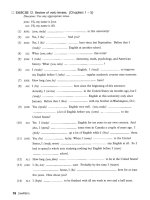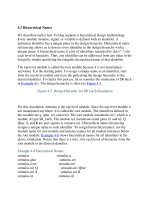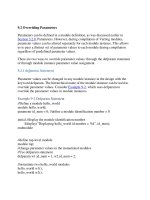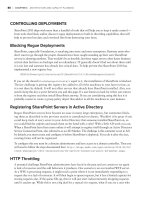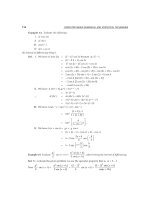Verilog Programming part 14 ppsx
Bạn đang xem bản rút gọn của tài liệu. Xem và tải ngay bản đầy đủ của tài liệu tại đây (49.74 KB, 12 trang )
6.3 Expressions, Operators, and Operands
Dataflow modeling describes the design in terms of expressions instead of
p
rimitive gates. Expressions, operators, and operands form the basis of dataflow
modeling.
6.3.1 Expressions
Expressions are constructs that combine operators and operands to produce a
result.
// Examples of expressions. Combines operands and operators
a ^ b
addr1[20:17] + addr2[20:17]
in1 | in2
6.3.2 Operands
Operands can be any one of the data types defined in Section 3.2
, Data Types.
Some constructs will take only certain types of operands. Operands can be
constants, integers, real numbers, nets, registers, times, bit-select (one bit of vector
net or a vector register), part-select (selected bits of the vector net or register
vector), and memories or function calls (functions are discussed later).
integer count, final_count;
final_count = count + 1;//count is an integer operand
real a, b, c;
c = a - b; //a and b are real operands
reg [15:0] reg1, reg2;
reg [3:0] reg_out;
reg_out = reg1[3:0] ^ reg2[3:0];//reg1[3:0] and reg2[3:0] are
//part-select register operands
reg ret_value;
ret_value = calculate_parity(A, B);//calculate_parity is a
//function type operand
6.3.3 Operators
Operators act on the operands to produce desired results. Verilog provides various
types of operators. Operator types are discussed in detail in Section 6.4
, Operator
Types.
d1 && d2 // && is an operator on operands d1 and d2
!a[0] // ! is an operator on operand a[0]
B >> 1 // >> is an operator on operands B and 1
[ Team LiB ]
[ Team LiB ]
6.4 Operator Types
Verilog provides many different operator types. Operators can be arithmetic,
logical, relational, equality, bitwise, reduction, shift, concatenation, or conditional.
Some of these operators are similar to the operators used in the C programming
language. Each operator type is denoted by a symbol. Table 6-1
shows the
complete listing of operator symbols classified by category.
Table 6-1. Operator Types and Symbols
Operator
Type
Operator
Symbol
Operation
Performed
Number of
Operands
Arithmetic *
/
+
-
%
**
multiply
divide
add
subtract
modulus
power (exponent)
two
two
two
two
two
two
Logical !
&&
||
logical negation
logical and
logical or
one
two
two
Relational >
<
>=
<=
greater than
less than
greater than or equal
less than or equal
two
two
two
two
Equality ==
!=
===
!==
equality
inequality
case equality
case inequality
two
two
two
two
Bitwise ~
&
|
^
^~ or ~^
bitwise negation
bitwise and
bitwise or
bitwise xor
bitwise xnor
one
two
two
two
two
Reduction &
~&
|
~|
^
^~ or ~^
reduction and
reduction nand
reduction or
reduction nor
reduction xor
reduction xnor
one
one
one
one
one
one
Shift >>
<<
>>>
<<<
Right shift
Left shift
Arithmetic right shift
Arithmetic left shift
Two
Two
Two
Two
Concatenation { } Concatenation Any number
Replication { { } } Replication Any number
Conditional ?: Conditional Three
Let us now discuss each operator type in detail.
6.4.1 Arithmetic Operators
There are two types of arithmetic operators: binary and unary.
Binary operators
Binary arithmetic operators are multiply (*), divide (/), add (+), subtract (-), power
(**), and modulus (%). Binary operators take two operands.
A = 4'b0011; B = 4'b0100; // A and B are register vectors
D = 6; E = 4; F=2// D and E are integers
A * B // Multiply A and B. Evaluates to 4'b1100
D / E // Divide D by E. Evaluates to 1. Truncates any fractional part.
A + B // Add A and B. Evaluates to 4'b0111
B - A // Subtract A from B. Evaluates to 4'b0001
F = E ** F; //E to the power F, yields 16
If any operand bit has a value x, then the result of the entire expression is x. This
seems intuitive because if an operand value is not known precisely, the result
should be an unknown.
in1 = 4'b101x;
in2 = 4'b1010;
sum = in1 + in2; // sum will be evaluated to the value 4'bx
Modulus operators produce the remainder from the division of two numbers. They
operate similarly to the modulus operator in the C programming language.
13 % 3 // Evaluates to 1
16 % 4 // Evaluates to 0
-7 % 2 // Evaluates to -1, takes sign of the first operand
7 % -2 // Evaluates to +1, takes sign of the first operand
Unary operators
The operators + and - can also work as unary operators. They are used to specify
the positive or negative sign of the operand. Unary + or – operators have higher
p
recedence than the binary + or – operators.
-4 // Negative 4
+5 // Positive 5
N
egative numbers are represented as 2's complement internally in Verilog. It is
advisable to use negative numbers only of the type integer or real in expressions.
Designers should avoid negative numbers of the type <sss> '<base> <nnn> in
expressions because they are converted to unsigned 2's complement numbers and
hence yield unexpected results.
//Advisable to use integer or real numbers
-10 / 5// Evaluates to -2
//Do not use numbers of type <sss> '<base> <nnn>
-'d10 / 5// Is equivalent (2's complement of 10)/5 = (2
32
- 10)/5
// where 32 is the default machine word width.
// This evaluates to an incorrect and unexpected result
6.4.2 Logical Operators
Logical operators are logical-and (&&), logical-or (||) and logical-not (!). Operators
&& and || are binary operators. Operator ! is a unary operator. Logical operators
follow these conditions:
1. Logical operators always evaluate to a 1-bit value, 0 (false), 1 (true), or x
(ambiguous).
2. If an operand is not equal to zero, it is equivalent to a logical 1 (true
condition). If it is 01equal to zero, it is equivalent to a logical 0 (false
condition). If any operand bit is x or z, it is equivalent to x (ambiguous
condition) and is normally treated by simulators as a false condition.
3. Logical operators take variables or expressions as operands.
Use of parentheses to group logical operations is highly recommended to improve
readability. Also, the user does not have to remember the precedence of operators.
// Logical operations
A = 3; B = 0;
A && B // Evaluates to 0. Equivalent to (logical-1 && logical-0)
A || B // Evaluates to 1. Equivalent to (logical-1 || logical-0)
!A// Evaluates to 0. Equivalent to not(logical-1)
!B// Evaluates to 1. Equivalent to not(logical-0)
// Unknowns
A = 2'b0x; B = 2'b10;
A && B // Evaluates to x. Equivalent to (x && logical 1)
// Expressions
(a == 2) && (b == 3) // Evaluates to 1 if both a == 2 and b == 3 are true.
// Evaluates to 0 if either is false.
6.4.3 Relational Operators
Relational operators are greater-than (>), less-than (<), greater-than-or-equal-to
(>=), and less-than-or-equal-to (<=). If relational operators are used in an
expression, the expression returns a logical value of 1 if the expression is true and
0 if the expression is false. If there are any unknown or z bits in the operands, the
expression takes a value x. These operators function exactly as the corresponding
operators in the C programming language.
// A = 4, B = 3
// X = 4'b1010, Y = 4'b1101, Z = 4'b1xxx
A <= B // Evaluates to a logical 0
A > B // Evaluates to a logical 1
Y >= X // Evaluates to a logical 1
Y < Z // Evaluates to an x
6.4.4 Equality Operators
Equality operators are logical equality (==), logical inequality (!=), case equality
(===), and case inequality (!==). When used in an expression, equality operators
return logical value 1 if true, 0 if false. These operators compare the two operands
bit by bit, with zero filling if the operands are of unequal length. Table 6-2
lists the
operators.
Table 6-2. Equality Operators
Expression Description
Possible Logical
Value
a == b a equal to b, result unknown if x or z in a or
b
0, 1, x
a != b a not equal to b, result unknown if x or z in a
or b
0, 1, x
a === b a equal to b, including x and z 0, 1
a !== b a not equal to b, including x and z 0, 1
It is important to note the difference between the logical equality operators (==, !=)
and case equality operators (===, !==). The logical equality operators (==, !=) will
yield an x if either operand has x or z in its bits. However, the case equality
operators ( ===, !== ) compare both operands bit by bit and compare all bits,
including x and z. The result is 1 if the operands match exactly, including x and z
bits. The result is 0 if the operands do not match exactly. Case equality operators
never result in an x.
// A = 4, B = 3
// X = 4'b1010, Y = 4'b1101
// Z = 4'b1xxz, M = 4'b1xxz, N = 4'b1xxx
A == B // Results in logical 0
X != Y // Results in logical 1
X == Z // Results in x
Z === M // Results in logical 1 (all bits match, including x and z)
Z === N // Results in logical 0 (least significant bit does not match)
M !== N // Results in logical 1
6.4.5 Bitwise Operators
Bitwise operators are negation (~), and(&), or (|), xor (^), xnor (^~, ~^). Bitwise
operators perform a bit-by-
b
it operation on two operands. They take each bit in one
operand and perform the operation with the corresponding bit in the other operand.
If one operand is shorter than the other, it will be bit-extended with zeros to match
the length of the longer operand. Logic tables for the bit-by-bit computation are
shown in Table 6-3
. A z is treated as an x in a bitwise operation. The exception is
the unary negation operator (~), which takes only one operand and operates on the
bits of the single operand.
Table 6-3. Truth Tables for Bitwise Operators
Examples of bitwise operators are shown below.
// X = 4'b1010, Y = 4'b1101
// Z = 4'b10x1
~X // Negation. Result is 4'b0101
X & Y // Bitwise and. Result is 4'b1000
X | Y // Bitwise or. Result is 4'b1111
X ^ Y // Bitwise xor. Result is 4'b0111
X ^~ Y // Bitwise xnor. Result is 4'b1000
X & Z // Result is 4'b10x0
It is important to distinguish bitwise operators ~, &, and | from logical operators !,
&&, ||. Logical operators always yield a logical value 0, 1, x, whereas bitwise
operators yield a bit-by-bit value. Logical operators perform a logical operation,
not a bit-by-bit operation.
// X = 4'b1010, Y = 4'b0000
X | Y // bitwise operation. Result is 4'b1010
X || Y // logical operation. Equivalent to 1 || 0. Result is 1.
6.4.6 Reduction Operators
Reduction operators are and (&), nand (~&), or (|), nor (~|), xor (^), and xnor (~^,
^~). Reduction operators take only one operand. Reduction operators perform a
bitwise operation on a single vector operand and yield a 1-bit result. The logic
tables for the operators are the same as shown in Section 6.4.5, Bitwise Operators.
The difference is that bitwise operations are on bits from two different operands,
whereas reduction operations are on the bits of the same operand. Reduction
operators work bit by bit from right to left. Reduction nand, reduction nor, and
reduction xnor are computed by inverting the result of the reduction and, reduction
or, and reduction xor, respectively.
// X = 4'b1010
&X //Equivalent to 1 & 0 & 1 & 0. Results in 1'b0
|X//Equivalent to 1 | 0 | 1 | 0. Results in 1'b1
^X//Equivalent to 1 ^ 0 ^ 1 ^ 0. Results in 1'b0
//A reduction xor or xnor can be used for even or odd parity
//generation of a vector.
The use of a similar set of symbols for logical (!, &&, ||), bitwise (~, &, |, ^), and
reduction operators (&, |, ^) is somewhat confusing initially. The difference lies in
the number of operands each operator takes and also the value of results computed.
6.4.7 Shift Operators
Shift operators are right shift ( >>), left shift (<<), arithmetic right shift (>>>), and
arithmetic left shift (<<<). Regular shift operators shift a vector operand to the
right or the left by a specified number of bits. The operands are the vector and the
number of bits to shift. When the bits are shifted, the vacant bit positions are filled
with zeros. Shift operations do not wrap around. Arithmetic shift operators use the
context of the expression to determine the value with which to fill the vacated bits.
// X = 4'b1100
Y = X >> 1; //Y is 4'b0110. Shift right 1 bit. 0 filled in MSB position.
Y = X << 1; //Y is 4'b1000. Shift left 1 bit. 0 filled in LSB position.
Y = X << 2; //Y is 4'b0000. Shift left 2 bits.
integer a, b, c; //Signed data types
a = 0;
b = -10; // 00111 10110 binary
c = a + (b >>> 3); //Results in -2 decimal, due to arithmetic shift
Shift operators are useful because they allow the designer to model shift
operations, shift-and-add algorithms for multiplication, and other useful operations.
6.4.8 Concatenation Operator
The concatenation operator ( {, } ) provides a mechanism to append multiple
operands. The operands must be sized. Unsized operands are not allowed because
the size of each operand must be known for computation of the size of the result.
Concatenations are expressed as operands within braces, with commas separating
the operands. Operands can be scalar nets or registers, vector nets or registers, bit-
select, part-select, or sized constants.
// A = 1'b1, B = 2'b00, C = 2'b10, D = 3'b110
Y = {B , C} // Result Y is 4'b0010
Y = {A , B , C , D , 3'b001} // Result Y is 11'b10010110001
Y = {A , B[0], C[1]} // Result Y is 3'b101
6.4.9 Replication Operator
Repetitive concatenation of the same number can be expressed by using a
replication constant. A replication constant specifies how many times to replicate
the number inside the brackets ( { } ).
reg A;
reg [1:0] B, C;
reg [2:0] D;
A = 1'b1; B = 2'b00; C = 2'b10; D = 3'b110;
Y = { 4{A} } // Result Y is 4'b1111
Y = { 4{A} , 2{B} } // Result Y is 8'b11110000
Y = { 4{A} , 2{B} , C } // Result Y is 8'b1111000010
6.4.10 Conditional Operator
The conditional operator(?:) takes three operands.
Usage: condition_expr ? true_expr : false_expr ;
The condition expression (condition_expr) is first evaluated. If the result is true
(logical 1), then the true_expr is evaluated. If the result is false (logical 0), then the
false_expr is evaluated. If the result is x (ambiguous), then both true_expr and
false_expr are evaluated and their results are compared, bit by bit, to return for
each bit position an x if the bits are different and the value of the bits if they are the
same.
The action of a conditional operator is similar to a multiplexer. Alternately, it can
be compared to the if-else expression.
Conditional operators are frequently used in dataflow modeling to model
conditional assignments. The conditional expression acts as a switching control.
//model functionality of a tristate buffer
assign addr_bus = drive_enable ? addr_out : 36'bz;
//model functionality of a 2-to-1 mux
assign out = control ? in1 : in0;
Conditional operations can be nested. Each true_expr or false_expr can itself be a
conditional operation. In the example that follows, convince yourself that (A==3)
and control are the two select signals of 4-to-1 multiplexer with n, m, y, x as the
inputs and out as the output signal.
assign out = (A == 3) ? ( control ? x : y ): ( control ? m : n) ;
6.4.11 Operator Precedence
Having discussed the operators, it is now important to discuss operator precedence.
If no parentheses are used to separate parts of expressions, Verilog enforces the
following precedence. Operators listed in Table 6-4
are in order from highest
p
recedence to lowest precedence. It is recommended that parentheses be used to
separate expressions except in case of unary operators or when there is no
ambiguity.
Table 6-4. Operator Precedence
Operators Operator Symbols Precedence
Unary + - ! ~ Highest precedence
Multiply, Divide, Modulus * / %
Add, Subtract + -
Shift << >>
Relational < <= > >=
Equality == != === !==
Reduction &, ~&
^ ^~
|, ~|
Logical &&
||
Conditional ?: Lowest precedence
